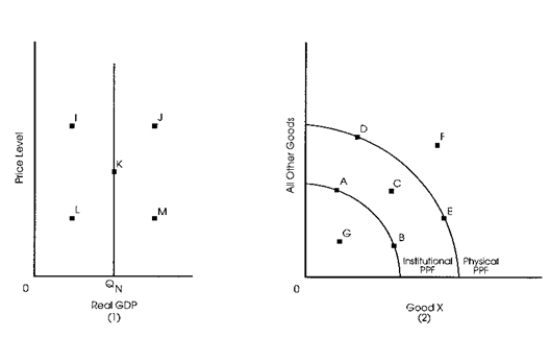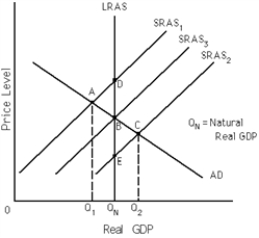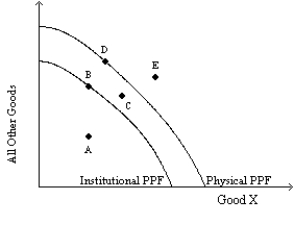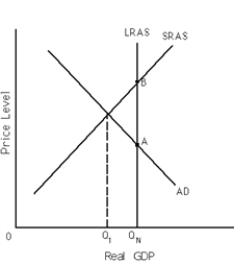A) If current Real GDP is greater than Natural Real GDP,the economy is in a recessionary gap.
B) If current Real GDP is less than Natural Real GDP,the economy is in long-run equilibrium.
C) Wages are flexible if the economy is self-regulating.
D) Wages rise but prices remain constant in long-run equilibrium.
E) All economists believe the economy is self-regulating.
Correct Answer

verified
Correct Answer
verified
Multiple Choice
Exhibit 9-5  -Refer to Exhibit 9-5.Imagine an AD curve intersecting an SRAS curve at Point K on graph (1) .Which point(s) would this correspond to on graph (2) ?
-Refer to Exhibit 9-5.Imagine an AD curve intersecting an SRAS curve at Point K on graph (1) .Which point(s) would this correspond to on graph (2) ?
A) A or B
B) C
C) D or E
D) F
E) G
Correct Answer

verified
Correct Answer
verified
Multiple Choice
Exhibit 9-3  -Refer to Exhibit 9-3.If the economy is in short-run equilibrium at point A,
-Refer to Exhibit 9-3.If the economy is in short-run equilibrium at point A,
A) the (actual) unemployment rate is less than the natural unemployment rate.
B) the (actual) unemployment rate is equal to the natural unemployment rate.
C) the (actual) unemployment rate is greater than the natural unemployment rate.
D) the relationship between the (actual) unemployment rate and the natural unemployment rate cannot be determined from the available information.
Correct Answer

verified
Correct Answer
verified
Multiple Choice
Exhibit 9-7  -Refer to Exhibit 9-7.Which point is representative of the economy in a recessionary gap?
-Refer to Exhibit 9-7.Which point is representative of the economy in a recessionary gap?
A) A
B) B
C) C
D) D
E) E
Correct Answer

verified
Correct Answer
verified
Multiple Choice
Exhibit 9-5  -A laissez-faire macroeconomic policy,based on a __________ in self regulating properties of the economy,implies __________ by the government.
-A laissez-faire macroeconomic policy,based on a __________ in self regulating properties of the economy,implies __________ by the government.
A) belief;active policymaking
B) belief;noninterference
C) disbelief;active policymaking
D) disbelief;noninterference
Correct Answer

verified
Correct Answer
verified
Multiple Choice
Suppose the economy is self-regulating,the price level is 120,the quantity demanded of Real GDP and the quantity supplied of Real GDP in the short run both equal $5.7 trillion,and the quantity supplied of Real GDP in the long run is $5.2 trillion.Given all of this information,we can conclude that the economy ____________ in short run equilibrium,and that the price level in long run equilibrium will be _____________ than 120.
A) is not;less
B) is;greater
C) is;less
D) is not;greater
Correct Answer

verified
Correct Answer
verified
Multiple Choice
When there is a recessionary gap, (actual) Real GDP is __________ Natural Real GDP,and the (actual) unemployment rate is __________ the natural unemployment rate.
A) greater than;less than
B) greater than;greater than
C) greater than;equal to
D) less than;greater than
E) less than;less than
Correct Answer

verified
Correct Answer
verified
Multiple Choice
Exhibit 9-5  -If the current Real GDP is less than Natural Real GDP,then the economy is
-If the current Real GDP is less than Natural Real GDP,then the economy is
A) in long-run equilibrium.
B) in a recessionary gap.
C) in an inflationary gap.
D) possibly in short-run equilibrium.
E) b and d
Correct Answer

verified
Correct Answer
verified
Multiple Choice
An inflationary gap exists when AD and SRAS
A) fail to intersect.
B) intersect to the right of Natural Real GDP.
C) intersect to the left of Natural Real GDP.
D) both have a positive slope.
Correct Answer

verified
Correct Answer
verified
Multiple Choice
According to Say's law,
A) if there is demand for a good,someone will supply it.
B) production creates demand sufficient to purchase all goods and services produced.
C) supply and demand work together to determine price.
D) trading takes longer in a barter economy than in a money economy.
E) none of the above
Correct Answer

verified
Correct Answer
verified
Multiple Choice
If Real GDP is less than Natural Real GDP,then the (actual) unemployment rate is
A) less than the natural unemployment rate.
B) equal to the natural unemployment rate.
C) greater than the natural unemployment rate.
D) less than or greater than the natural unemployment rate,but we cannot determine which one.
E) b and d
Correct Answer

verified
Correct Answer
verified
Multiple Choice
According to classical economists,if interest rates are flexible,
A) saving will equal investment.
B) saving may be greater than investment.
C) saving may be less than investment.
D) any of the above
Correct Answer

verified
Correct Answer
verified
Multiple Choice
Exhibit 9-5  -The frictional unemployment rate is 2.5 percent,the structural unemployment rate is 3.1 percent,and the economy's current unemployment rate is 5.6 percent.The economy is in
-The frictional unemployment rate is 2.5 percent,the structural unemployment rate is 3.1 percent,and the economy's current unemployment rate is 5.6 percent.The economy is in
A) an inflationary gap producing more than Natural Real GDP.
B) a recessionary gap producing more than Natural Real GDP.
C) an inflationary gap producing Natural Real GDP.
D) a recessionary gap producing less than Natural Real GDP.
E) long-run equilibrium.
Correct Answer

verified
Correct Answer
verified
Multiple Choice
The classical economists felt that there would be no general overproduction of goods because of
A) wage-price flexibility.
B) the law of diminishing utility.
C) the law of comparative advantage.
D) contestable markets.
Correct Answer

verified
Correct Answer
verified
Multiple Choice
A recessionary gap exists if (actual) Real GDP is __________ Natural Real GDP.
A) less than
B) greater than
C) equal to
D) b and c
E) none of the above
Correct Answer

verified
Correct Answer
verified
True/False
In a self-regulating economy,a recessionary gap will be eliminated by falling wages which will shift the SRAS curve to the right.
Correct Answer

verified
Correct Answer
verified
Multiple Choice
Exhibit 9-1  -Refer to Exhibit 9-1.If the economy is self-regulating,the price level is
-Refer to Exhibit 9-1.If the economy is self-regulating,the price level is
A) lower in short-run equilibrium than in long-run equilibrium.
B) lower in long-run equilibrium than in short-run equilibrium.
C) higher in long-run equilibrium than in short-run equilibrium.
D) lower when the economy is in a recessionary gap than when it is in long-run equilibrium.
E) a and c
Correct Answer

verified
Correct Answer
verified
True/False
All economists agree that the economy is self-regulating.
Correct Answer

verified
Correct Answer
verified
Multiple Choice
When the economy is producing the level of output equal to natural Real GDP,the unemployment rate is equal to
A) zero.
B) the natural unemployment rate.
C) the frictional unemployment rate.
D) the structural unemployment rate.
Correct Answer

verified
Correct Answer
verified
Multiple Choice
If Real GDP is less than Natural Real GDP,the economy is in
A) an inflationary gap.
B) a recessionary gap.
C) an unemployment gap.
D) a real gap.
Correct Answer

verified
Correct Answer
verified
Showing 41 - 60 of 159
Related Exams